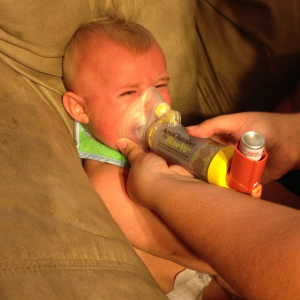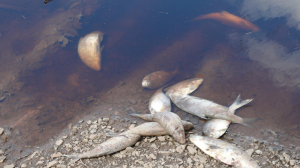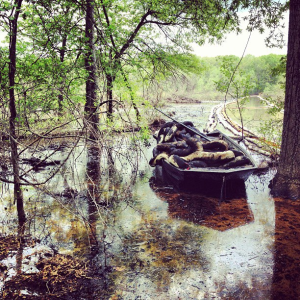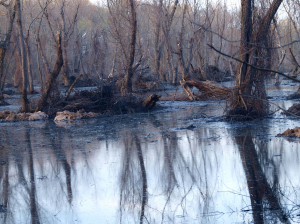Plans to build the Keystone XL pipeline—designed to pump 35 million gallons of tar sands oil a day through the heart of America—are on hold, stalled by legal challenges about its route to Gulf Coast refineries from Canada. Yet there are very few answers to questions about the health risks involved in moving that kind of oil, as pipeline accidents in Michigan and Arkansas are demonstrating. WhoWhatWhy takes a look at those questions in the second part of a series.

The question of whether tar sands are hazardous to our health is growing stickier.
A final decision from the Obama administration on the Phase 4 construction of the much-debated Keystone XL pipeline remains on hold, stalled by legal challenges to its planned route through the state of Nebraska.
But other questions have been raised in Congress about the possible health effects that may result from pumping 35 million gallons a day of diluted bitumen—tar sands oil—through a pipeline every day from Alberta, Canada, through the heart of America to refineries on the Gulf Coast. And there are questions that are barely being asked or answered. Here, we take a look at some of them.
***
It has now been over a year since ExxonMobil’s Pegasus pipeline ruptured, immersing the Northwoods subdivision in Mayflower, Arkansas, and nearby Lake Conway in 210,000 gallons of Canadian heavy crude. Many residents are still suffering from serious health problems they blame on that spill.
A far larger spill in July 2010 dumped more than a million gallons of tar sands oil from an Enbridge Energy pipeline into yards, fields, and the Kalamazoo River in Marshall, Michigan. Citizens are still waiting for information on chemical exposure and health risks from the Michigan Department of Community Health—information that’s now three years overdue, according to Marshall resident Susan Connolly, a paralegal who testified at a Congressional hearing on the spill.

No one knows exactly which chemicals were in the oil that inundated these communities—nor do doctors, researchers or regulators know just how harmful they might be.
As we explained in Part 1 of this series, published in 2013, tar sands oil is not conventional crude. It’s a viscous mix of sand and tarry petroleum known as bitumen that is so thick that it must be diluted with liquefied natural gas and various chemicals so it can flow through a pipeline. Any of 1,000 chemicals may be used to make diluted bitumen, or “dilbit”—and companies are permitted by the government to conceal those formulas as trade secrets.
These unknowns prompted the U.S. Senate Environment Committee to request a “comprehensive study on the human health impacts of tar sands oil and the proposed pipeline.” In a letter to Secretary of State John Kerry in February, senators called the health information in the most recent State Department environmental review “woefully inadequate.” In April, a State Department official confirmed that they “will address health impacts” but did not talk about plans to start a broad independent health study.
Acute Exposure
On March 29, 2013, oil streamed from the ruptured pipeline and fumes enveloped Mayflower in a caustic petrochemical plume, sickening hundreds of people in this small working class community of 2,200 people. It smelled like asphalt, but worse, says Genieve Long, a mother of four who lives beside the lake. “The air was so thick it burned your lungs. It burned your eyes,” Long told WhoWhatWhy.
Crude oil contaminated 22 properties in the Northwoods subdivision; those families were evacuated, but neighbors who lived just a few hundred yards away or along oil-slicked Lake Conway were not. Many, including Arkansas’ Attorney General Dustin McDaniel, later questioned why everyone living in close proximity had not been removed.
Intense exposure sparked acute symptoms that for many, persisted for three to four months: Residents dry heaved or vomited for days on end; they suffered from bowel issues, endless migraines, nosebleeds, exhaustion, dizzy spells and confusion; their skin was covered in rashes that resembled chemical burns—and they gasped for breath.
It was a mirror image of what had happened to the citizens of Marshall, Michigan, after the Enbridge spill three years before. A state report found that nearly 60 percent of those living in the vicinity experienced the same health problems.
“These are classic symptoms of acute exposure to both airborne petrochemicals and to the chemicals used to liquefy the thick Canadian tar sands oil,” says Wilma Subra, an environmental scientist who works with communities impacted by oil spills. “There’s an entire population that’s been made very, very sick by the emissions.”
Limited Information
Because ExxonMobil barred news reporters from the area after the Arkansas spill, little information was available in the early days, said Ann Jarrell, who lived 300 yards from the site. Those who contacted police, the health department, or the company, she said, were repeatedly assured there was no danger.
The overpowering stench in their oil-soaked neighborhood prompted her daughter, Jennifer, to call the Mayflower police department: She was worried about her four-month-old infant. When she asked if they should evacuate, she was told that if there was no oil on their property, they should be fine—but both Ann and Jennifer were nauseous and coughed constantly, their heads pounding.
***
No government agency stepped forward to educate the public about health risks, and state officials told residents that contaminants in the air were “below levels likely to cause health effects for the general population” in an online press release. So even though they were sick, most people stayed in their homes, either because they’d been told to, couldn’t afford to leave, or simply had nowhere else to go.
In the event of an oil spill, there is little guidance from the federal government: There are no federal guidelines on when—or if—the public should be evacuated, nor protocols for evaluating public health after exposure. At a press conference, Attorney General McDaniel expressed concern about “the short- and long-term effects of carcinogens released into the air which are still detectable in the living rooms of people in that area.”
Five months after the spill, the state finally offered Mayflower residents free health assessments. For many, their problems had been compounded by the fact that most doctors have little training or experience diagnosing or treating chemical exposures. And though citizens pushed Exxon and the health department to establish a centrally located clinic and bring in specialists versed in occupational and environmental medicine, it never happened.

Long-term Effects
It’s hard to know what, if anything, to do about tar sands oil, since there are no data on the long-term health effects of exposure to it. And there are few efforts to correct that knowledge gap—so it’s difficult to assess what safety regulations are needed to properly protect the public.
Susan Connolly advocated for an ongoing epidemiological study of those who were affected in Marshall, but was repeatedly rebuffed. April Lane, an expert on the health effects of fossil fuels, also wanted to collect health data in Mayflower, but her request for federal funding was turned down. Without such studies, it is impossible to track the incidence of chronic illnesses or cancers that may result from living amidst an oil spill. Subra notes that these people are continually re-exposed.
For some Mayflower residents, pre-existing conditions have worsened. Others now suffer from chronic health issues that have appeared in the months since the spill. Among the more serious cases are people hospitalized with kidney infections or “chemical pneumonitis,” a type of pneumonia. “It’s not a ‘one size fits all,’” says Lane. “Each person reacts differently to toxins.”
Severe respiratory problems have repeatedly landed Jennifer Jarrell’s son, Logan, in the emergency room over the past year and he now uses a steroid inhaler twice daily to breathe. His grandmother Ann, lost her voice, her thyroid levels skyrocketed, and her headaches grew so intense that her doctor suspected a brain tumor and sent her for an MRI.
***
Genieve Long, who lives on Lake Conway, stayed because it was impossible to uproot four kids without any assistance. Six months post-spill, she mysteriously developed gallstones and kidney stones that weren’t there nine months earlier when she’d had diagnostic scans for something else. She was told that it should take years, not months, to develop stones as large as hers. Her question now: “What’s going to happen to me or my kids in 20 years?”
Though they no longer smell oil every day, whenever boaters disturb Lake Conway’s shallow waters, or windy, rainy weather stirs up the water, tar balls rise and petroleum rainbows slick the lake’s surface. The family’s early, acute symptoms return along with a metallic, chemical taste in their mouths. They start wheezing, they can’t think straight, and they’re again plagued by headaches. Long’s two youngest children have been left with poorly functioning lungs, she says, and struggle to breathe every day.
Residual dilbit is a big problem, especially around waterways. Unlike normal oil, heavy tar sands oil sinks. Once the diluting chemicals evaporate, it reverts to its original viscous state and is almost impossible to remove.
ExxonMobil’s remediation work in Lake Conway is still under way. And in Michigan, Enbridge’s cleanup efforts continue as the company struggles to remove the estimated 180,000 gallons of dilbit that remains submerged in the Kalamazoo River and its tributaries, which has already cost over a billion dollars, with a minimum of $22 million in fines still looming for Clean Water Act violations.
With Petrochemicals, How Little is Too Much?
Aaron Stryk, a spokesperson for ExxonMobil, told WhoWhatWhy that contractors hired by the company conducted “exhaustive” air sampling and continuous air quality tests in Mayflower. They tested for three substances: benzene, hydrogen sulfide, and total volatile organic compounds (VOCs). The Environmental Protection Agency (EPA) also sampled air and monitored air quality, but only released data on total VOCs.
These grouped VOC readings don’t identify what chemicals are actually present in the air, nor their concentrations, says fossil fuels expert Lane. She explains that without identifying which chemicals are present—and in what amounts—it’s impossible to accurately gauge health risks.
Much of the focus was on benzene. It’s toxic in miniscule doses, and is known to cause leukemia and neurological problems and to lower immunity. In Mayflower, airborne benzene levels at the spill site averaged 0.6 parts per million, sometimes spiking to 2.2 parts per million.
There are dozens of government guidelines for benzene exposure. For example, Federal Agency for Toxic Substances and Disease Registry (ATSD) standards estimate that people can breathe air containing 9 parts-per-billion (ppb) for up to two weeks—or 6 ppb for up to a year—without adverse health effects. However, these guidelines did not include cancer risk—even though benzene is a known carcinogen.
Moreover, public health decisions become the domain of county or state officials after an oil spill—though such decisions often fall well outside their experience or expertise. The variations are staggering. In Arkansas, the Department of Health established the benzene exposure threshold at more than five times ATSD standards: 50 parts per billion for up to a six-month period. Lori Simmons, who runs the agency’s environmental epidemiology department, said that residents could be exposed to these levels without long-lasting health problems.

Health experts, including Wilma Subra, April Lane and others, are concerned that the state’s “safe” levels were set too high to protect the public—and that the health department failed to issue special warnings for those who are the most vulnerable to chemical exposures: pregnant women, the elderly and young children.
Communities get sick even when the concentrations are well below the more stringent federal “acceptable standards,” says Subra, and monitoring protocols are frequently insufficient. State and federal agencies may rely on equipment that monitors only in the parts-per-million range, which for some substances is not sensitive enough.
A growing body of research shows that infinitesimal doses of some chemicals can have serious effects. Over the last few decades, scientists have discovered that low-dose toxins may disrupt endocrine functions that orchestrate everything from growth, development, reproduction, immunity and cognition to memory and metabolism. The unborn are particularly at risk: Exposure in-utero can interfere with the gene-controlled signaling systems that influence every aspect of fetal development.
***
Effects of early exposure may not appear until later in life, and damaging genetic changes can be inherited by future generations. Health problems caused by these “endocrine disruptors” is a problem of such growing global concern that it prompted research on the state of the science by the World Health Organization in 2012.
But most chemicals have never been safety-tested. When the Toxic Substances Control Act of 1976 (TSCA) was introduced, it grandfathered in some 60,000-plus existing chemicals, assuming they were safe until proven otherwise. Since then, the EPA has required testing of about 200 of them and has partially regulated just five.
Manufacturers have provided little if any information to the agency on the safety of 22,000 chemicals created since then. According to the Natural Resources Defense Council, an environmental group, TSCA makes it “nearly impossible for the EPA to take regulatory action against dangerous chemicals, even those that are known to cause cancer or other serious health effects.”
For a decade prior to his death last year, Senator Frank Lautenberg (D-NJ), fought to overhaul chemical safety laws. But the Chemicals in Commerce Act that was introduced in the House in February has drawn fire, with critics arguing that the proposed legislation would weaken current regulations by pre-empting state standards and allowing companies to conceal the chemicals used in their products.
In both Marshall and Mayflower another knowledge gap became glaringly obvious: There has been virtually no testing of either the cumulative effects of various chemicals—or their combined, synergistic effects—on the human body.
Trade Secrets May Endanger Public Health
It’s all a little like KFC and their secret recipe. Companies can legally withhold their “proprietary” dilbit formulas from regulators, including the EPA. Even the State Department’s 2013 Keystone XL environmental impact study lacked specific information on diluents: “The exact composition of the dilbit is not publicly available because the particular type of bitumen and diluents blend produced is variable and is typically a trade secret.”
That leaves the overseers in the dark. Carl Weimer, the executive director of the Pipeline Safety Trust, says that though regulators have some knowledge of what’s being used to thin heavy crude, they don’t know the contents of any particular batch. Over 1,000 chemicals may be present in dilbit, depending on what’s cheapest at the time. Many are hazardous to humans.
Independent air samples taken by Lane and analyzed by Subra on the first four days following the Mayflower accident were found to contain 30 chemicals.
“Each of the 30 hydrocarbons measured in the Mayflower release is a toxic chemical on its own and may pose a threat to human health depending on exposure and individual factors,” said Neil Carman, a former Texas Commission on Environmental Quality inspector who now is a Clean Air Program director with the Sierra Club.
What else citizens were breathing may be anyone’s guess because of the limited testing done on the air samples, Lane says. Her monitoring charted high levels of benzene, potentially dangerous concentrations of n-hexane, octane, and polycyclic aromatic hydrocarbons, which naturally occur in oil and tar deposits. Lower levels of butane, toluene, and other chemicals were also detected. Some of these are among the most toxic airborne chemicals regulated under the Clean Air Act Amendments of 1990.
Heavy Metals in the Heavy Crude
Alberta’s tar sands oil also carries heavy metals in significantly larger concentrations than those in conventional oil: mercury, manganese, nickel and chromium, which are toxic at high doses, as well as arsenic and lead, which damage the nervous system at relatively low doses. The list of potential maladies from these chemicals and heavy metals is long and frightening.
In 2009, the Alberta Research Council, a government-funded research and development corporation focusing on energy, reported that the region’s bitumen had 10 times the chromium and 38 times the manganese as Canada’s standard crude oil.
Without testing, it’s unclear whether these metals and other chemicals in bitumen are seeping into dwellings, gardens, the water table, or are present in dust and soil—and if so, at what levels.
Water testing in an oil-soaked area of Lake Conway known as “the Cove” has repeatedly measured manganese in amounts exceeding EPA safety standards for drinking water. In some cases, it has tested at 30 times acceptable levels.
Rising Imports, Rising Risks?
Concerns about tar sands extend beyond just the proposed Keystone XL pipeline. Tar sands oil imports from Canada have tripled over the past decade, jumping from 9.2 million gallons per day in 2000 to more than 27.3 million gallons in 2011. Producers hope to double that in the next five years, according to Canada’s National Energy Board.
To transport Canada’s heavy crude from Alberta’s landlocked tar sands to American refineries, the U.S. is constructing, or repurposing, a plethora of existing oil and gas pipelines, some of which have been in use for decades—and were constructed for much lighter loads. So no one knows how well those pipes will handle the tar sands oil.
In part because of the controversy and delays over the pipeline, Exxon is already making other plans: Starting in 2015, it will ship Canadian oil by train out of a newly built terminal, up to 4.2 million gallons a day. Rail transport poses its own risks. The last three years have seen seven out of the nation’s worst 10 railroad oil spills—dumping 1.2 million gallons in 2013 alone.
The Senate Committee on Environment and Public Works recently raised the larger issue about bringing greater quantities of diluted bitumen into the U.S., though they were specifically questioning Keystone XL.
“We believe that putting more Americans at risk for asthma, cancer, and other serious health impacts is not in our national interest,” the senators wrote.
Residents of Mayflower understand the risks firsthand. “There’s no fence that stops toxins,” says Genieve Long. “We’re the collateral damage.”
Correction: The original article incorrectly stated that the entire Keystone XL pipeline’s construction is on hold. We have corrected the post to clarify that it’s Phase 4 which has been stalled by a legal challenge.



